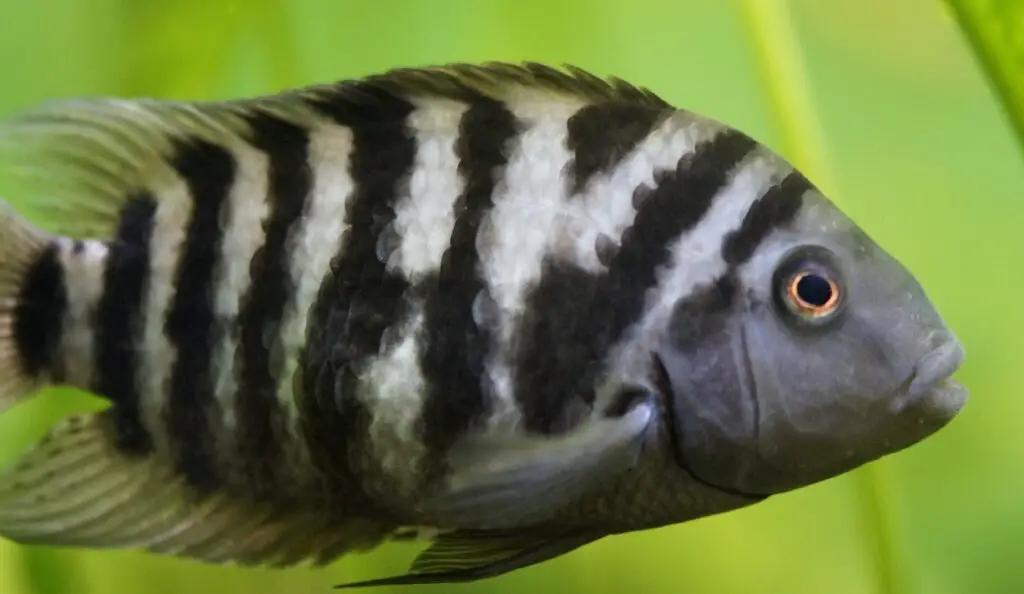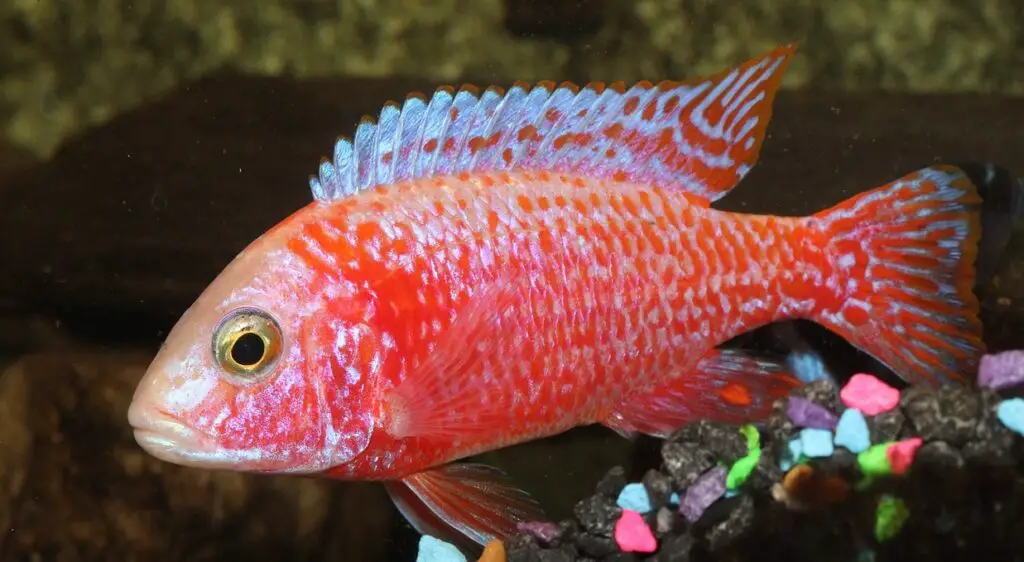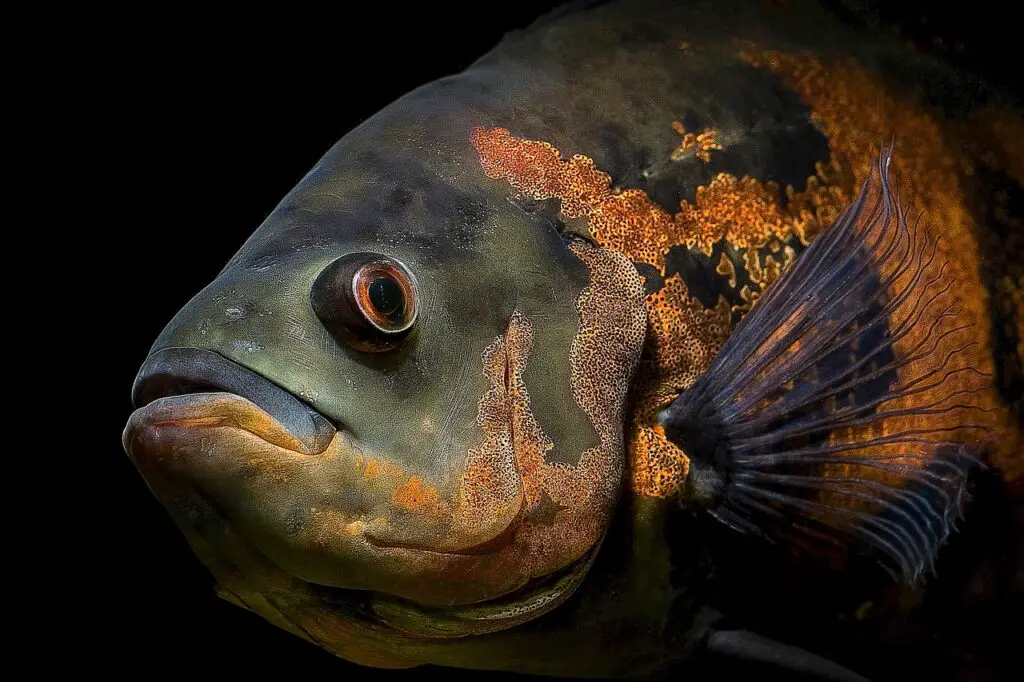This African Cichlid Care Guide will give you the knowledge necessary to give your fish a long and prosperous life. From tank setup tips to feeding suggestions, this guide is comprehensive yet easy for anyone who wants to keep their African cichlids thriving.
By learning how to care for your African cichlids properly, you can ensure they live a whole, healthy life filled with joy and happiness! So let’s begin our journey into the world of African Cichlids!
What Are African Cichlids?
African cichlids are part of a large family of freshwater fish called Cichlidae. They hail from the African continent, and there are many different species to choose from, making them famous aquarium inhabitants. These colorful creatures can thrive in home aquaria for years with proper care!
When choosing an African cichlid for your tank, it’s essential to consider its size, maturity, temperament, and diet requirements. Some species may grow too big or become aggressive if kept with other fish, so research is vital when selecting suitable species for you. Additionally, each species has unique dietary needs that must be met to ensure optimal health and growth. Providing adequate space for the cichlids to have enough room to swim around comfortably is also essential.
African cichlids generally require clean water with a neutral pH of 6.8-7.5 and weekly partial water changes to maintain excellent water quality and keep their scales vibrant and healthy. Furthermore, regular maintenance, such as gravel vacuuming, should be done once per month to remove any debris or waste buildup on the aquarium floor that could potentially harm the fish.
Knowing how to care for your African cichlids properly will help ensure they live a long and happy life in your home aquarium – now let’s look into where these fascinating creatures call home: their natural habitat!

Natural Habitat Of African Cichlids
African cichlids call a variety of aquatic habitats in Africa their home, from large lakes to smaller streams and rivers. Determining the best setup for your tank can be easier if you understand what natural habitat these fish are familiar with. Here are a few essential factors to consider when designing an aquarium that mimics its native environment:
1) Water Conditions – African cichlids prefer water temperatures between 72-80°F (22-27°C). They also require clean water with neutral pH levels ranging from 6.8-7.5 and good filtration and aeration systems to keep the water oxygenated.
2) Substrate – Natural substrates such as sand or gravel can help recreate the feeling of living in their wild habitats while providing hiding places for them to explore and feel secure. Additionally, adding rocks and driftwood offers visual interest and other hideaways where they can rest or lay eggs during the breeding season.
3) Lighting – African Cichlids need moderate lighting levels—not too bright but not completely dark—to provide enough light for plants to grow and stay healthy. Aim for 8 hours of light per day using full spectrum LED bulbs specifically designed for freshwater tanks.
4) Plants – Adding live plants is beneficial for many reasons, including creating shade spots, stimulating spawning behavior, encouraging grazing habits, and even helping filter out unwanted toxins in the water column. Try choosing slow-growing species like Anubias or Java Fern that won’t get overwhelmed by hungry cichlid mouths!
Knowing about the natural habitat requirements of African cichlids will help make setting up a thriving aquarium much easier! With this information, it’s time to start building an ideal home for these fantastic creatures so they can thrive in captivity!
Setting Up An Aquarium For African Cichlids
Setting up an aquarium for African cichlids is a fun and exciting process that will create the perfect home for these amazing creatures. The first step to setting up a successful tank is selecting the proper size—it’s always choosing one large enough so they can swim freely, with plenty of space for decorations and plants. A general rule of thumb is 10 gallons per adult cichlid when stocking multiple species together, but this may vary depending on individual fish size and needs.
Once your tank is ready, it’s time to add water! Ensure the temperature and pH levels are within acceptable ranges before introducing fish into the habitat; ideal parameters should be between 72-80°F (22-27°C) and 6.8-7.5, respectively. It’s also wise to use aged water or dechlorinated tap water as chlorine can be toxic for them if present in higher concentrations.
Finally, consider which type of cichlid(s) you’d like to keep. Some species require more elaborate setups than others due to their specific requirements, such as additional filtration systems or larger tanks. Researching each species before purchase will help ensure you get the best setup possible while providing everything they need to thrive in captivity. With all these elements taken care of, we’re ready to move on to feeding requirements for our new aquatic friends!
Feeding Requirements Of African Cichlids
Now that we have our aquarium, it’s time to consider what diet African cichlids require. These fish are omnivores and should be provided with a varied diet to ensure they receive all the proper nutrients for optimal health. Several food sources are available, including flakes, pellets, frozen foods, live foods, freeze-dried options, and more. It’s essential to research each species before purchase as some may need additional dietary components such as specific vitamins or minerals.
When creating a feeding strategy for your fish, pay close attention to their individual needs—some can tolerate larger meals, while others benefit from smaller ones throughout the day. Generally speaking, though, most adult cichlids should be fed twice daily in amounts equal to no more than 5% of their body weight at each meal. For example, if you had four 6 inches, long adults, you would feed them around 1/4 cup total per day split into two separate servings.
It is also essential not to overfeed; excess proteins and uneaten food can lead to water pollution, which will eventually cause harm to your aquatic friends. Removing invisible leftovers after 10 minutes is always the best practice to maintain good water quality levels inside the tank. With this knowledge, we can now move on to the breeding and reproduction of African cichlids – an exciting adventure!

Breeding And Reproduction Of African Cichlids
Captivating cichlids and their captivating courtship: the breeding and reproducing of African cichlids is a fascinating journey. To ensure success, several requirements must be met to prepare for these fish’s rofish’s rendezvous properly.
First, it is essential to understand the distinct pairing behavior of each species you plan on introducing into your tank. Researching this information will help you identify which cichlids would make good mates and provide insight into what environment they need to reproduce successfully. Of course, if any aggression arises, it’s best to separate them immediately and try again with other partners.
Once a compatible pair has been established, providing them with adequate food sources will improve their chances of spawning. This could include water-borne insects or live foods such as worms and brine shrimp. Adjusting the water parameters can also increase fertility; slightly rising temperatures and adding soft acidic water may stimulate mating behaviors in some species, while others prefer cooler waters and higher pH levels. Here are four essential tips when considering breeding African Cichlids:
• Consider compatibility when selecting pairs
• Provide plenty of food for successful spawning
• Adjust water parameters according to individual needs
• Monitor closely for signs of aggression
With these strategies in mind, we can now look towards disease prevention & treatment for African cichlids – an essential topic all aquarists should be familiar with!
Disease Prevention & Treatment For African Cichlids
As a responsible aquarist, knowing the potential diseases that can affect African cichlids is imperative. Being proactive and taking steps towards prevention will help ensure these fish live healthily in the aquarium environment.
The most important form of disease prevention for African cichlids is proper aquarium maintenance and water quality control. Regularly checking parameters such as pH and nitrate levels will go a long way in helping maintain good health among your tank’s inhabitants. Furthermore, providing a clean substrate, regular partial water changes, and removing uneaten food promptly are all critical elements of keeping an optimal aquatic habitat.
When preventative measures fail, treatments are still available to cure illnesses common to this species. While medications may be necessary if bacterial or parasitic infections occur, many fish ailments can often be addressed by simply improving the living conditions within their tanks – so getting back on track with good care practices should always be a priority! Additionally, consulting with experienced aquarists or veterinarians specializing in treating ornamental fish can provide invaluable insight into recognizing signs of illness early on before they become more severe.
No matter how diligent we may be in preventing the disease from occurring in our tanks, it’s possible that specific issues could arise over time. Taking preventive measures and knowing what treatments are available for African cichlids ensures their continued happiness and well-being – something every responsible aquarist strives for!

Frequently Asked Questions
How Long Do African Cichlids Usually Live?
Have you ever wondered how long your African cichlids will live? It’s a great question to ask, especially if you’re just starting out in the hobby of fishkeeping. Knowing your watery pets’ life expectancy and longevity can help you plan ahead for their needs. Let’s dive into what affects an African cichlid’s lifespan:
- Environmental factors:
- Water quality
- Stress level
- Care practices:
- Diet
- Tank setup
Regarding environmental factors, ensuring the tank has pristine water quality is vital for healthy living conditions. If the aquarium is too dirty or lacks proper filtration and circulation systems, it could increase stress levels in your cichlids, which may shorten their lifespan. The same goes for care practices; providing them with a balanced diet and ensuring they have enough space in the tank are essential components that contribute to their overall health and well-being.
It is important to note that while all these elements play a role in maintaining good aquatic health, there isn’t one particular factor alone that determines the length of an African cichlid’s life span. Studies show that most African cichlids typically live between 5-10 years under optimal conditions. However, in some cases, individual fishes have lived longer than ten years due to high-quality maintenance and management!
With the consistent effort put into caring for your beloved fish, they can enjoy many happy years swimming around together in your home aquarium!
How Difficult Is It To Take Care Of African Cichlids?
Caring for African cichlids can be difficult, especially if you are new to the hobby. This is because a lot of information needs to be taken into account to ensure they remain healthy and happy. Care has many aspects, including tank setup, water parameters, diet, and keeping tips, and all these elements need to be balanced for them to thrive.
Some important steps should be followed when setting up an environment suitable for African cichlids. The size and type of tank needed to depend on how many fish will be kept and their species. Additionally, specific water parameters like pH levels must also be considered based on the specific requirements of each species. Furthermore, tanks need regular maintenance, such as cleaning filters and changing the water regularly for optimal health.
Choosing the proper diet for African cichlids is equally essential when caring for them properly. They require high-quality food with plenty of variety to get nutrients from different sources. Different types of food should also be provided depending on what kind of fish you have in your tank – omnivores or herbivores – ensuring that all dietary needs are met adequately.
TIP: When selecting a care guide for your African cichlid setup, ensure you get one tailored explicitly towards this particular breed, providing detailed instructions about best practices and appropriate products needed within their unique ecosystem!
What Is The Best Water Temperature For African Cichlids?
Water temperature is essential for their health and well-being when it comes to keeping fish. But when you talk about African cichlids specifically, the optimal water temperature can be a tricky thing to figure out. What exactly is the best temperature range for these exotic species?
African cichlids require warm temperatures that mimic those of their native environment to thrive. The tank should remain between 78-82°F (25-28°C). This will ensure your African cichlids are comfortable and healthy in their new home. It’s also important to keep the fluctuations within this range as consistent as possible so they won’t become stressed or lethargic due to extreme environmental changes.
That said, providing the proper water temperature isn’t enough. If you want your African cichlids to live long and happy lives in captivity, you’ll need to pay attention to other factors like pH levels, oxygen content, and nitrate levels. Creating a balanced ecosystem will help them stay active and healthy while living in your tank!
What Can Other Types Of Fish Be Kept With African Cichlids?
When it comes to keeping fish, one of the most important things is selecting compatible tank mates. African cichlids are no different, and choosing the suitable companion species for your cichlid can be challenging. Here are some tips on what other types of fish you can keep with African cichlids:
- Tank size & Diet Requirements:
- Ensure you have enough space in your aquarium for all the fish living together. The larger the tank, the better, as each type of fish needs room to swim. Also, consider diet requirements – for example, if you plan to add omnivorous or carnivorous species into an herbivore-only tank, they may not get along well because there won’t be enough food sources available.
- Cichlid Species:
- It’s best to choose tank mates from similar regions as your African cichlids so they feel more at home and don’t experience too much stress while adapting to their new environment. For instance, west African cichlids can do well with rainbowfish, tetras, or barbs. In contrast, east African cichlids work best with smaller mbuna (rock-dwelling) species like peacock basses or large catfish such as Synodontis Multipunctatus.
- Compatible Fish:
- Lastly, look for peaceful fish breeds that aren’t overly aggressive but still active enough to help keep your tank clean and healthy by eating excess algae growths and leftover food particles. Some good choices include silver dollars, danios, rasboras, and neon tetras – just make sure they’re big enough (at least 3 inches long), so they don’t become snack food!
Choosing compatible tank mates can be tricky, but with these tips, you’ll have everything you need to find suitable companions for your African cichlid(s). Remember that research is key when adding new additions to your aquarium – take time to learn about each breed before introducing them into your watery world!
How Often Should African Cichlids Be Fed?
Caring for African Cichlids can be a rewarding experience, but one of the most important aspects to consider is how often they should be fed. This question has many answers depending on factors such as tank size, water temperature, and age. We must understand their natural feeding habits to provide them with the best possible care.
Looking at African cichlids’ natural environment, it becomes apparent that they have evolved to eat frequently throughout the day due to competition from other fish species. In an aquarium setting, this means providing multiple meals per day rather than giving them one large meal every few days. The frequency of feedings will vary depending on the individual needs of each fish, so understanding their unique dietary requirements can help us create an effective feeding schedule.
Meal size is also something to consider when creating a routine for your African Cichlid. Overfeeding can lead to several health issues, including bloating and constipation, while underfeeding may cause malnutrition or even starvation. To avoid these problems, ensure you only offer what your cichlid will consume within two minutes- any uneaten food should be removed after that period.
Appropriate feed frequency plays a key role in caring for African Cichlids successfully. When done correctly, you’ll be rewarded with healthy and happy fish who thrive in their home aquarium environment!
Conclusion
In conclusion, African cichlids can be a great addition to any aquarium if the proper care and maintenance requirements are met. With their bright colors and unique personalities, these fish excite any tank. While it may seem daunting initially, taking care of African cichlids is not that difficult once you understand how they work. To ensure your fish live long and healthy lives, you must provide them with good water parameters, an appropriate diet, and compatible tank mates. If all these things are considered, you’re off to a great start!
Caring for African Cichlids is no walk in the park – but when done right, it can certainly be rewarding. Keeping African Cichlids can be incredibly gratifying as long as you take the time to do adequate research beforehand and remain vigilant about meeting their needs on an ongoing basis. After all – knowledge truly is power in this regard; those who have mastered what it takes to keep these beautiful creatures will reap the benefits tenfold!
